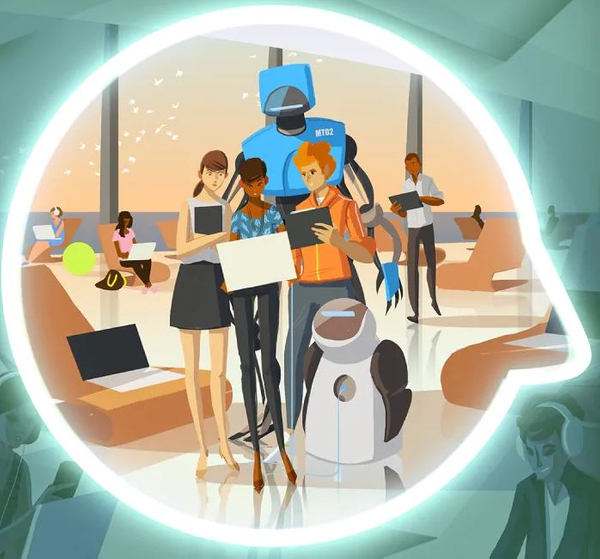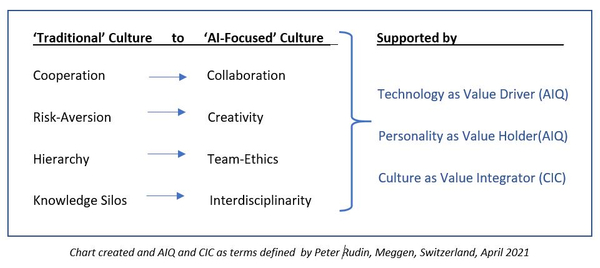 Belonging Picture Credit: www2.deloitte.com
Belonging Picture Credit: www2.deloitte.com
Introduction
In the latest survey Juniper Networks found that 95% of respondents believe that their organization would benefit from embedding AI into their daily operations. However, only 6% of those reported adoption of AI-powered solutions across their business: AI is Accelerating… is Your Organization Ready? (juniper.net). This is Jupiter’s second recent report to peg data issues as the reason organizations fail to successfully deploy AI. Inherent biases in the data being used create compliance risks. 73% of Juniper’s survey respondents said that their organizations were struggling to integrate their workforce with AI-systems. Similar findings are reported from O’Reilly in the report ‘AI Adoption in the Enterprise 2021’: O’Reilly – AI Adoption in the Enterprise 2021 (oreilly.com). Problems with data quality, a lack of trained human resources and a lack of leadership governance seem to be the main reasons why the implementation of AI is stalling. The very few that have succeeded provide the showcase for consulting companies to sell their services. However, looking from the top-down and the challenges ahead, one can conclude that the prevailing corporate culture and its lack of adaptation to the AI value-drivers is the main stumbling block.
From Digital-Transformation to AI-Transformation
Digital-Transformation is based on advanced data analytics and machine-supported pattern recognition, embracing the conversion from an analogue to a digital representation of ‘reality’. Coupled with exponentially growing computing resources, it has enabled organizations to digitize their operational processes with substantial financial rewards, reducing production costs and improving customer communication. While Digital-Transformation is setting the stage for moving on to AI-Transformation it appears that many corporations are struggling in realizing its potential benefits. Advances in neuroscience and behavioural research are stipulating a fundamental mind-change in the development and application of AI. This mind-change far exceeds the goals originally defined by the 4th Industrial Revolution, opening-up a new frontier in economics and social issues. Changing a culture requires time, typically 5-10 years. Hence, to master the increasing complexity produced by advances in AI-research and its impact on AI-Transformation demands a corporate culture that supports these changes at all levels.
What is a Corporate Culture?
There is no precise definition, but it is generally agreed that a corporate culture must mirror business objectives and that corporate culture has a huge impact on the fortune of a company and its employees. Corporate culture, also known as company culture, refers to a set of beliefs and behaviours that guide how a company’s management and employees interact and how they handle external business transactions. Some components of corporate culture might include vision, values, practices, people and customer engagement. For instance, corporate culture might be reflected in the way a corporation hires and promotes employees or by the wording of its corporate mission statement. Some companies seek to associate themselves with a specific set of values, such as by defining themselves as an “innovative” or “environmentally conscious” organization. Potential employees might be attracted to companies whose cultures they identify with, which in turn drives employee retention and new talent acquisition. For companies focused on innovation, fostering a culture of innovation can be critical to maintaining a competitive edge with respect to patents or other forms of intellectual property. Similarly, corporate culture can also play a role in marketing the company to customers and to society at large through public relation activities. Besides these specific definitions, one must view corporate culture in terms of company size as well. While Start-ups and the venture capitalists engaged define their own cultural development – carrying the risk of many failures vis-à-vis the potential of huge financial rewards – small, mid-sized and large, stock-market listed companies and the business segment they are engaged in differ widely as to how they can adapt their culture to a rapidly changing industrial landscape where innovation is or will be the key value driver.
Employee-Engagement: A Key Indicator in Assessing Corporate Culture
While Digital-Transformation and the streamlining of the organization’s processes are in full swing, employee engagement for achieving corporate goals remains one of the key indicators in assessing the effectiveness of the prevailing corporate culture. Analysing this engagement also provides an indicator for actions to be taken if the company does not perform. According to the last Gallup survey , 67% of all U.S. workers are NOT actively and emotionally engaged in identifying with the company’s goals: State of the American Workplace (gallup.com). Engaged employees act with a sense of ownership and take initiative in problem solving without being told what to do. Many leaders mistakenly think that increasing employee satisfaction will increase employee engagement and motivation. Employee engagement does not mean employee happiness or satisfaction. Someone might be happy at work, but that does not necessarily mean they are working hard on behalf of the organization. Satisfaction is transactional and contractual. In return for their work, the company provides employees with the basics of compensations, tools, and resources, physical safety, dignity, and respect. Satisfied employees will put out as much effort as they are compensated for, and no more. They show up and do their work, but this does not necessarily mean that they are going to say no to other offers, hence their loyalty to the organization remains low. When it comes to the all-important bottom line of financial success, employee engagement (not satisfaction or happiness) matters. It is a powerful engine for growth and profit. When analysing employee engagement, it is important to recognize that we are looking at a 50/50 proposition between the organization and the employee: the organization creates and maintains the culture required in return for the employee being emotionally engaged. As a result, both, employee and organization will benefit.
AI as Driver of a Cultural Shift
Although AI has surpassed expectations in specific applications (dubbed Narrow AI), a seemingly insurmountable gap remains between artificial and human intelligence. To overcome this gap, it is necessary to establish a bridge between biological brain science and AI-research, equivalent to a transfer from knowing the brain to simulating the brain. With this bridge in place, we can test and compare our true thinking capacity with artificially computed results. Exploring brain functionality by applying brain-imaging technologies, for example, enables us to correlate neuroscientific experiments with the results of mathematical modelling. Today the path from learning to thinking represents a major hurdle for achieving human-like intelligence. It is likely, however, that within decades the computational and algorithmic capacity of AI will outperform human intelligence in problem-solving tasks, challenging humans and society as to how to best take advantage of AI without losing control. Complementing biological with artificial intelligence provides a framework for testing our own biological intelligence against its artificial, computational replication for solving a given problem. Doing so, we must understand the limits and advantages of the artificial version as much as we need to understand the limits of our own personality and our ability to make a judgement regarding the solution proposed. For example, using an AI-system to express empathy might provide biased results or a self-driving robot might interpret a physical condition the wrong way, causing an accident. Hence, in addition to IQ und EQ, a newly defined AIQ is required for testing one’s creativity and ability to assess the solution proposed by the AI-system, stipulating a mindset of understanding biological as well as artificial intelligence: The Need to Redefine Intelligence: From IQ to EQ to AIQ › SINGULARITY 2030. While the AIQ assesses an individual’s ability to establish a bridge between technology and personality for applying AI to problem-solving, the organizational and corporate environment to attract and engage these talents is tightly connected to its corporate culture and its capacity to adapt to a rapidly changing socio-economic environment.
The Implementation of an AI-focused Corporate Culture
The characteristics and processes of an ‘AI-focused’ company differ substantially from the way a ‘traditional company’ performs. Hence major adjustments are necessary to establish the corresponding cultural framework. The following chart describes this transition process:

Collaboration is the key in mastering the raising complexity of science and technology. Mastering the transition from cooperation to collaboration is challenging and highly dependent on the composition and motivation of the leadership-team. Next to the cultural components like creativity, team ethics and interdisciplinarity, new management roles are being defined such as:
- Coaching members in support of team-ethics and trust, fostering credibility
- Parenting members in support of personal development, fostering engagement
- Knowledge-sharing in support of interdisciplinarity, fostering life-long-learning
These activities and their impact over time can be measured. Hence, next to the term AIQ, a newly defined term CIC, or ‘Cultural Innovation Code’ serves as indicator for the potential success of an organization aimed at AI-focused value-generation.
Conclusion
A key role in supporting a company’s cultural transition rests with the individuals responsible for talent acquisition. Next to assessing and hiring the best talents, there is a growing trend towards the so-called GIG-Economy, where highly qualified individuals seek assignments defined by the timeline of a specific project before moving on to the next contract. To these individuals a fulfilling ‘work-life-balance’ is as important as the financial rewards. According to the Gallup survey, 53% of employees say a role that allows them to have greater ‘work-life-balance’ and better personal well-being is “very important”. The Covid-Pandemic has accelerated this trend, partially supported by the implementation of new communication technologies (home-office, videoconferencing). As life returns to ‘normal’, offering and supporting a fulfilled ‘work-life-balance’ and raising employee engagement to participate in high-performance teams will be the key to realizing corporate innovation- and sustainability-goals. Most importantly, collaboration is a prerequisite for collective intelligence, the Nr.1 success factor in mastering corporate complexity and possibly the future benchmark for ‘survival-of-the-fittest’.